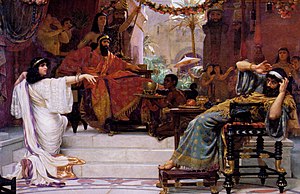
If you are new to synagogue, Purim is either a treat or a shock, maybe both. It’s a holiday based in the Biblical book of Esther, which is such a wild, farcical document that it very nearly didn’t get included in the Bible. Here’s what you need to know:
1. WHEN? Purim falls on 14 Adar. In a leap year, it falls on 14 Adar II. There may be something called Shushan Purim on your Jewish calendar, but you only need to worry about it if you live in a walled city such as Jerusalem. For conversion to the secular calendar, check a Jewish calendar.
2. THE STORY For the whole megillah [scroll] read the Book of Esther in the Bible. The short version: The Jewish community in Persia is nearly annihilated when King Ahasuerus’s chief minister, Haman, takes a dislike to them. The king’s queen, Esther, is secretly a Jew and she intervenes to save the day. The full story, in the Bible, is at least R-rated for both sex and violence, but in most American synagogues what you will hear is the G-rated version edited for children’s ears.
3. MITZVAH 1 – HEAR THE STORY. We are commanded to hear the story every year. We fulfill that mitzvah either by hearing the scroll chanted or by seeing it acted out in a Purim Shpiel, with lots of audience participation. It is traditional to drown out the name of the villain, Haman, with noisemakers like groggers or with boos.
4. MITZVAH 2 – FESTIVE BANQUET. We are commanded to enjoy a festive meal on Purim. One theme for the holiday is feasting – if you read the story, you’ll notice there are lots of parties in it. Hamentaschen are three-cornered filled cookies associated with the holiday.
5. MITZVAH 3 – GIFTS TO POOR PEOPLE. We are commanded to see to it than even the poorest people can enjoy a festive meal – hence, gifts of food to the poor. (A donation to the Food Bank in your area works nicely.)
6. MITZVAH 4 – MISHLOACH MANOT (Meesh-LOW-ach man-OAT) are small gifts of baked goods, wine, or other goodies, given to friends to enhance their feasting. Ideally they are a little package of more than one goodie.
7. COSTUMES. Many Jews, both children and adults, wear costumes to synagogue for the Purim festivities. Often people dress as characters from the Purim story, but pirates, astronauts, and superheroes are good, too. Some just wear a mask for Purim, because one of the themes of the holiday is secret identities.
8. DRINKING. There is a tradition that one should drink “until one cannot tell Haman from Mordechai” – the bad guy from the good guy. This, too, is a theme from the story but it has too often been taken to excess. Don’t drink and then drive home from synagogue, or push alcohol on anyone, please. No matter what anyone tells you, getting drunk is never a mitzvah.

5 thoughts on “Purim for Beginners”